Contributory members are able to log private notes and comments about each site
Sites Anne T has logged. View this log as a table or view the most recent logs from everyone
Duns Mercat Cross
Trip No.105 Entry No.1 Date Added: 4th Nov 2018
Site Type: Ancient Cross
Country: Scotland (Scottish Borders)
Visited: Yes on 27th Oct 2018. My rating: Condition 3 Ambience 3 Access 5

Duns Mercat Cross submitted by Anne T on 4th Nov 2018. The current market cross, moved to its present location in 1897.
(View photo, vote or add a comment)
Log Text: Duns Mercat Cross: Having set off after a snow storm this morning, we stopped off in Duns just after 12 noon for coffee and a scone.
We went to the café we went to when we were here last (some 3-4 years ago), only to find the café open but no-one in, despite many cars in the town. Parking just round the corner from the market square, I realised that there was a market cross which I don’t think I’d photographed before. Whilst the base was ‘modern’ the top appears old.
The café had changed hands, reverting to the original owner, who admitted to being 76 years old and having run a gallery in Harrogate. “We don’t do lunches” we were told. By this time we were cold and hungry so opted for hot scones and tea. A great selection of very reasonably priced antiques to browse round, too, although the only thing I would really have liked to buy wasn't for sale!
The plaque on the cross base reads: “The Mercat Cross of Duns originally stood on the site of the present town hall and was removed when it was rebuilt in 1820. It was re-erected by Andrew Smith Esqr. of Whitchester AD 1897.”
Whiteadder Reservoir
Trip No.105 Entry No.2 Date Added: 4th Nov 2018
Site Type: Cairn
Country: Scotland (East Lothian)
Visited: Yes on 27th Oct 2018. My rating: Condition 2 Ambience 4 Access 4

Whiteadder Reservoir submitted by Anne T on 4th Nov 2018. This appears to be all that is left of the stone setting and cairn, although the grass and bracken were mid-calf height, so other stones could have been hidden underneath. The cairn is easily identifiable, as it stands above the surrounding ground level, with a stone emerging from one side of the centre of the mound. This view is looking west north west over the cairn.
(View photo, vote or add a comment)
Log Text: Whiteadder Reservoir cairn and stone setting: We parked at NT 64304 64291 and walked along the first part of the Herring Road onto the land high above Whiteadder Reservoir with the GPS to find this stone setting and enclosure, with the cold winds whipping around our ears. From what I'd read on Canmore, I expected something a little different from what we found on the ground, which was in effect a cairn.
Despite walking round the area looking for these stones, and trying to feel for stones under our feet, we only found what looked like a cairn with one stone sticking up out of it. It is the same area as that given by Canmore. A 1971 entry says the enclosure has been completely destroyed, except "three small stones exist." As the grass and heather was calf deep, it was probable the stones were hidden underneath.
Looking at the map on the Canmore record, the cairn we spotted is in the correct location for the stones, with the enclosure about 20m to the south, identifiable as there is a flat, circular area in the bracken. Beautiful views over the reservoir.
The sign on the ‘public path’ signpost reads: Heritage Path, Herring Road. This old path is named because it was used by the fishwives of Dunbar when carrying massive creels of herring to market in Lauder. This track was one of many different routes that were used by the fishwives over the centuries as paths became eroded and were replaced.” And “Herring Road to Dunbar, 12.5miles via Dunbar Common and Halls”.
Rood Well
Trip No.105 Entry No.5 Date Added: 5th Nov 2018
Site Type: Holy Well or Sacred Spring
Country: Scotland (East Lothian)
Visited: Yes on 27th Oct 2018. My rating: Condition 4 Ambience 4 Access 5
Rood Well submitted by KiwiBetsy on 2nd Oct 2006. The Rood Well, also known as The Well of the Holy Rood or the 'Cardinal’s Hat', sits beside the B6370. It is located in a small garden area on the northeastern edge of Stenton, on the left if you are heading for Dunbar.
(View photo, vote or add a comment)
Log Text: Rood Well, Stenton: A very pretty well, and very easy to find. Just by the side of the road, some 300 metres north east along the B6370 from The Tron. The well is below pavement level, with steps leading down to it. The well cavity was damp but there was no pool of water. I couldn’t see any pipe leading into the well chamber, so assume the water must seep up into the cavity. Being closely surrounded by a stone wall on three sides, with a ploughed field beyond, it was a little tricky to photograph.
As the Canmore entry from the Old Church (ID 57841) says, the finial on the well is thought to come from the Old Church (14th century). There is a small plaque on the side of the well which reads: “16th century historic building”.
Easter Broomhouse
Trip No.105 Entry No.8 Date Added: 5th Nov 2018
Site Type: Standing Stone (Menhir)
Country: Scotland (East Lothian)
Visited: Yes on 27th Oct 2018. My rating: Condition 3 Ambience 4 Access 4
Easter Broomhouse submitted by cosmic on 1st Jun 2008. Site in East Lothian:
Viewed from SE
(View photo, vote or add a comment)
Log Text: Easter Broomhouse Standing Stone: Dusk was falling as we arrived at this site, which I've long wanted to see. We parked by the water treatment works over the road at NT 67718 76493 and walked down the side of the ploughed area of the field until we were level with the stone, then ‘waded’ through the loose, ploughed soil until we reached the stone itself.
A lonely spot, although it has great views to the Firth of Forth and Bass Rock in the distance, to the north. It is a tall, sandstone pillar standing in an ocean of brown-red soil.
There are indeed 3 cups marks on its western face, along with some modern graffiti. The base of the stone has really been worn away; as the Canmore record says, this is the result of a steam plough cable.
Mayshiel Stone Circle
Trip No.105 Entry No.4 Date Added: 4th Nov 2018
Site Type: Stone Circle
Country: Scotland (East Lothian)
Visited: Yes on 27th Oct 2018. My rating: Condition 3 Ambience 4 Access 4
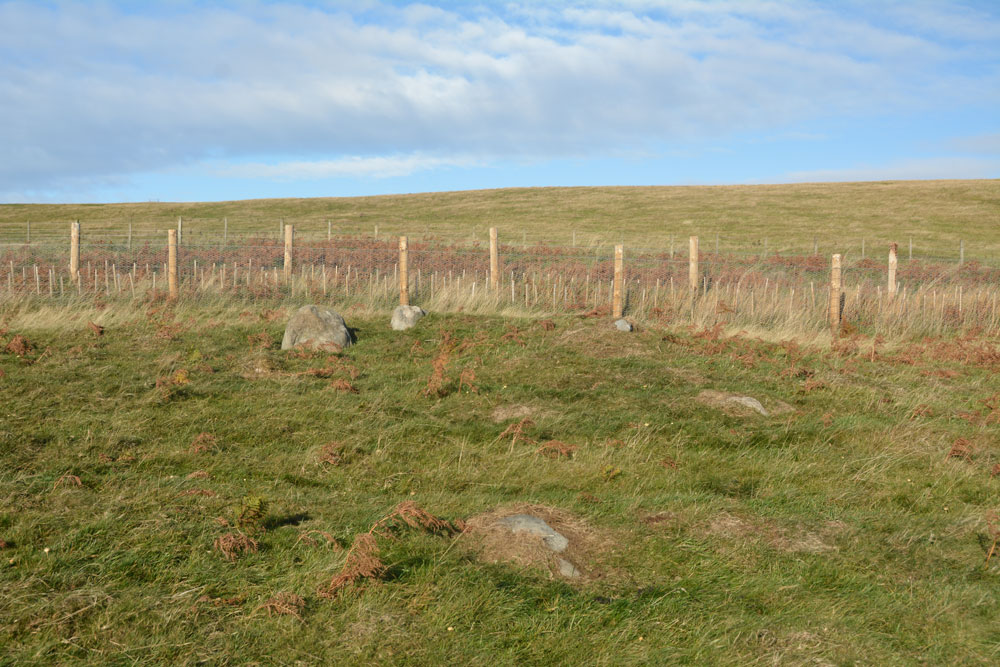
Mayshiel Stone Circle submitted by Anne T on 4th Nov 2018. The Mayshiel stones from the south. At the top of the slope, there were five stones which protruded out of the grass. Looking more closely, there were some further down-slope, largely hidden by turf, but nevertheless still part of this stone setting.
(View photo, vote or add a comment)
Log Text: Mayshiel Stone Setting: Whilst we were here to see the stones at NT 6298 6465, the first thing I spotted was a huge pile of clearance stones just up the hill in a field just north of the B6355. The second was what looked like a standing stone at the edge of the field at NT 62924 64612. On closer look, this may have been a large field clearance stone, which sits on top of other small boulders.
The stones at Mayshiel are very close to the road. At first glance, there are only three, but the longer we looked, more became evident.
There were also another group of stones at approx. NT 62814 64541 which had the appearance of a cist, but the stones forming the longer sides were very large. These stones may have just been a natural outcrop. One of the stones had been broken and the split off bit was lying half way along the northern end of the group.
Looking at the latter group of stones at home, they were similar in description to Canmore’s description of the Packman’s Grave (above).
At first glance, an insignificant site, but the more we walked round, the better it became, and it was well worth stopping off to look at this.
Witches' Stone (Spott)
Trip No.105 Entry No.6 Date Added: 5th Nov 2018
Site Type: Holy Well or Sacred Spring
Country: Scotland (East Lothian)
Visited: Yes on 27th Oct 2018. My rating: Condition 3 Ambience 3 Access 5

Witches' Stone (Spott) submitted by Anne T on 5th Nov 2018. This unprepossessing stone sits beneath a hedgerow, with a name sign and a small (now almost illegible information sign).
(View photo, vote or add a comment)
Log Text: The Witches' Stone, Spott: I had expected something a little grander than a large stone by the side of a hedgerow with a rusting iron railing and a sign that we could hardly read. There is a photograph on the Canmore record with a photograph of the sign from 2010 which is legible: “The Witches Stone of Spott. Marion Lillie, the Ringwoody Witch was burnt here in 1698. The stone is reputed to stand on the site of the burning of the last witch in the South of Scotland. Near to this site the Birley Tree stood, under whose branches the local Birley Court was held.”
I had to chuckle as whilst I was photographing a stone, another couple had stopped to take photographs of a brown sheep in a nearby field. Having taken quite a few photos, they continued their walk, walking right by this stone. Perhaps they’d seen it before. I found it touching that people still left coins here as offerings.
St John's Well (Spott)
Trip No.105 Entry No.7 Date Added: 5th Nov 2018
Site Type: Holy Well or Sacred Spring
Country: Scotland (East Lothian)
Visited: Yes on 27th Oct 2018. My rating: Condition 3 Ambience 3 Access 4
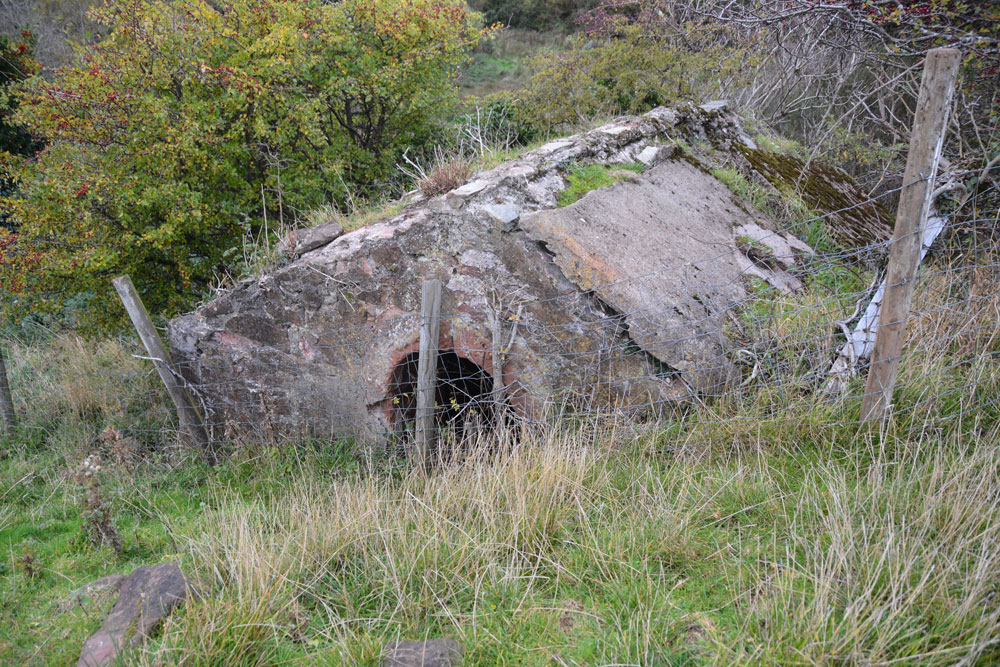
St John's Well (Spott) submitted by Anne T on 5th Nov 2018. This old cistern is some 100m further north, at the eastern side of the gully running from the well. I wondered if it was part of the 18th century works which piped water from this well into Dunbar.
(View photo, vote or add a comment)
Log Text: St John's Well, Spott: With the wind still whistling and starting to get dark, we really wanted to see this well and the nearby Easter Broomhouse standing stone before calling it a day. At the north eastern end of Spott, a gated stile by the small school lets you into the field, which, at the time of our visit, was full of very large, curious sheep.
Following the line of the first two telegraph poles, a gully comes into view. The well house is located at the top of this, at the bottom of the gully, so we needed to slither down the 6ft or so to the bottom to photograph the well.
Whilst the well cavity was dry, there was a pool of water a couple of metres further down the gulley.
Further down the field there was a very old, ruined building with an arched window. I am curious to know what this is – need to look it up on Canmore. Because of its location, my immediate thought was that it was a hermitage. No separate Canmore record, but is recorded on the map as a cistern.
St Cuthbert's Well (Mitford)
Trip No.104 Entry No.2 Date Added: 24th Oct 2018
Site Type: Holy Well or Sacred Spring
Country: England (Northumberland)
Visited: Yes on 24th Oct 2018. My rating: Condition 3 Ambience 3 Access 5

St Cuthbert's Well (Mitford) submitted by Anne T on 24th Oct 2018. The well/fountain housing is built into the wall of the Old Post Office, at the side of the B6343.
(View photo, vote or add a comment)
Log Text: Site of St Cuthbert's Holy Well, Mitford: After having visited Bothal church and spent well over an hour looking around, we stopped off at The Old Chantry tea rooms in Morpeth for a bowl of soup and a cup of tea, then headed off to the small, but very pretty village of Mitford, just over 2.5 km west of Morpeth.
OK, so there is no longer a well here, and the Victorian-era drinking fountain structure that was built in the place where the well was supposed to have been is now dry, it was easy to find. The road is reasonably busy, so I risked getting run over to get a few close up shots. The carving of the impaled dragon's head (I didn't realise what it was until I saw the photos on the larger screen of the computer and read the Historic England description) was pretty gruesome.
We did wander down to the river and walked along a little way. Someone has built what appears to be a very pretty, but very modern, thatched cottage by the side of the footpath along the river.
Note for next time: the pub does special offers on food for pensioners!
Jemmy's Well (Cambo)
Trip No.104 Entry No.3 Date Added: 25th Oct 2018
Site Type: Holy Well or Sacred Spring
Country: England (Northumberland)
Visited: Yes on 24th Oct 2018. My rating: Condition 3 Ambience 3 Access 4
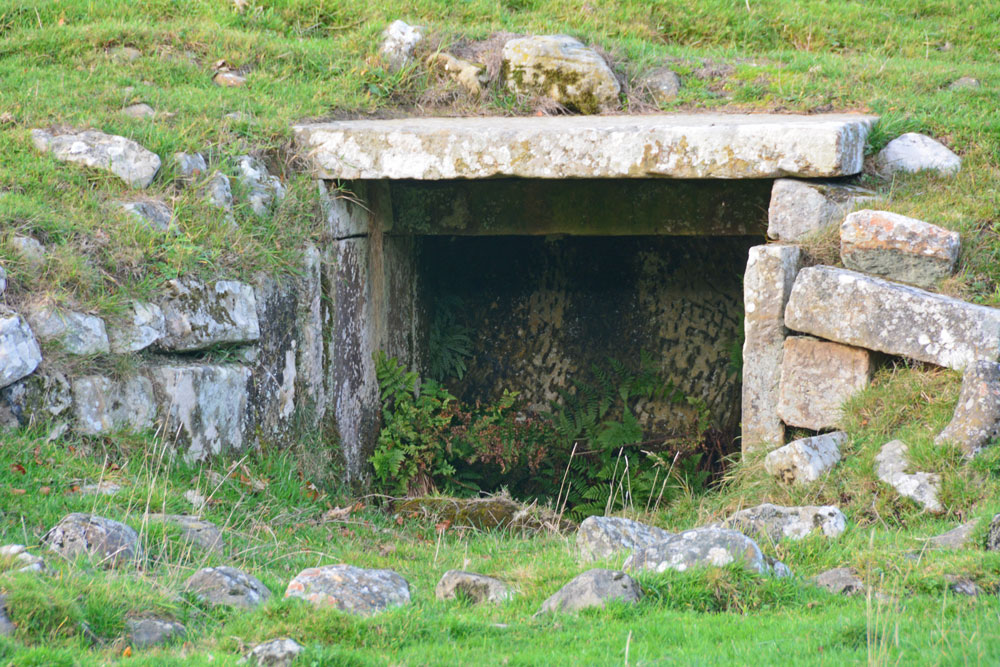
Jemmy's Well (Cambo) submitted by Anne T on 25th Oct 2018. Using the camera lens almost on maximum zoom to try and see the inside of the well house. I will try and get permission to walk across the field and take a closer look in the relatively near future. The half circle of stones outside the well house indicates there used to be a pool at some time in the fairly recent past.
(View photo, vote or add a comment)
Log Text: Jemmy's Well, Cambo: One of three wells in the village of Cambo, but only this one is marked on the modern OS map, and the only mention we found of it was in Binnall and Dodd's 1941 'Holy Wells of Northumberland and Durham' document. The well lies on private land, just south of Cambo School, and the well field had at least half a dozen horses in it; to avoid upsetting the horses, we let ourselves into the field to the south, using the gate near the wood alongside the B6342, then walking north to where a 'bridge/track' has been created over the small stream to the south of the well field.
I found the 1863 OS maps when I got home, and the other two wells are marked, to the south west of Jemmy's Well; where these are the two mentioned by Binnall and Dodds (Hepple's Well and Stinky), I'm not sure, but the are close enough to supply the village.
I'd like to get permission to get into the well field and take a closer look. Whilst the well looked dry at the time of our visit, the semi-circle of stones outside the well house indicated there had been a well pool there at some time in the fairly recent past.
Lady Well (Bavington)
Trip No.104 Entry No.4 Date Added: 25th Oct 2018
Site Type: Holy Well or Sacred Spring
Country: England (Northumberland)
Visited: Yes on 24th Oct 2018. My rating: Condition 2 Ambience 4 Access 4
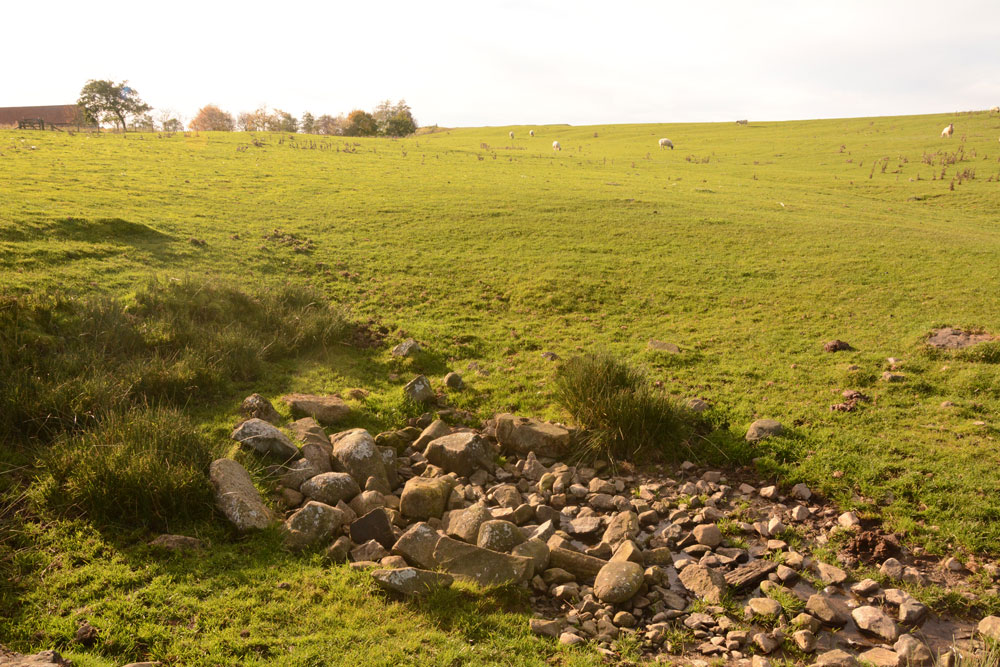
Lady Well (Bavington) submitted by Anne T on 25th Oct 2018. The well from the north east. From the relatively large number of dressed stones at and around the well head, it looks as if there was a well house or structure here at some time. This is the source of the Kirkharle Burn.
(View photo, vote or add a comment)
Log Text: Lady Well, Bavington: This is a lovely spot, and well worth the short walk to and from the road to see this well (or what remains of it).
We parked at NY 99286 80701, just off the B6342, and followed the track northwards towards Ladywell Farm. There was a big boulder with lots of cut marks at it at the top of the track, and I worked out it said ‘Ladywell’ on it, although the marks looked more like runes than letters!
There are no records on Pastscape or HE, although the well is marked on the OS map. Ladywell Farmhouse is recorded as Historic England List ID 1044928, although this is largely 17th and 18th century.
The footpath goes right past the right hand side of the farm, then deviates off slightly north east, through a kissing ate. Walking straight ahead, there was a dip in the ground with some marsh grass around it to our right, so we made a beeline for this. There was a heap of pebbles in the dip, with a stream of water emerging from the ground between the stones – no great rush of water, just a gentle flow. Judging by the dressed stones at the southern end of the pile of pebbles, it looks as through there might have been a well house or pool surround at some point.
Oh the wind, which must have been a steady 30mph plus on our walk there and back! My ears and cheeks burned when I got back into the car after this walk, although it was nice to actually walk to a site and back, even though it was a relatively short distance.
St Andrew's Church (Bothal)
Trip No.104 Entry No.1 Date Added: 25th Oct 2018
Site Type: Ancient Cross
Country: England (Northumberland)
Visited: Yes on 24th Oct 2018. My rating: Condition 3 Ambience 4 Access 5
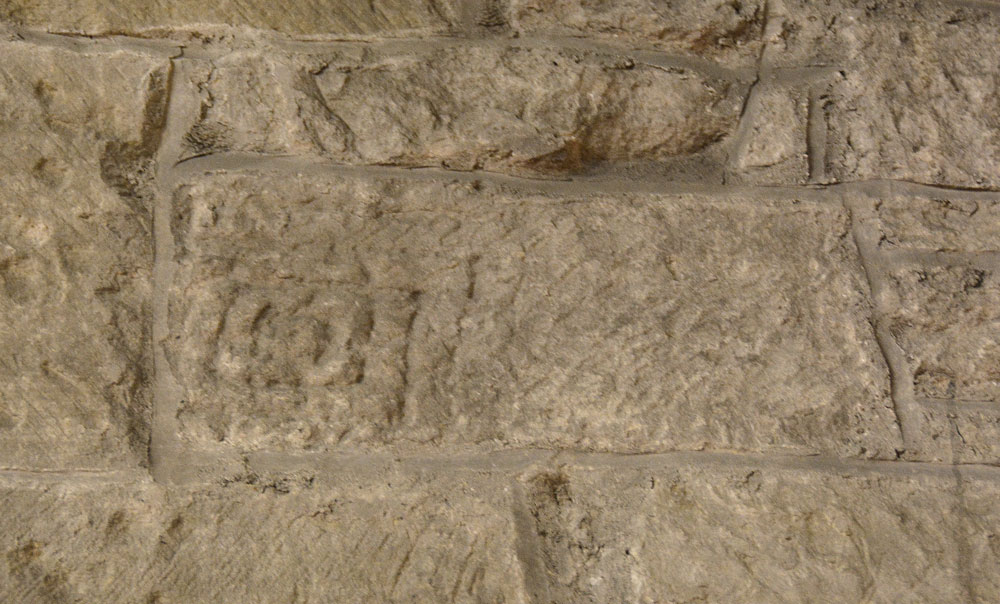
St Andrew's Church (Bothal) submitted by Anne T on 25th Oct 2018. This is AS Corpus Bothal 07, part of a cross shaft built into the north wall of the chancel (towards its western end). Dated to the late tenth to early eleventh century, we initially had difficulty in picking this stone out, but once we'd seen it, could not 'unsee' it. The Corpus describes the pattern as 'formed by concentric punch outlined rectangles with a coiled centre.'
(View photo, vote or add a comment)
Log Text: Anglo Saxon Cross Shaft Fragment, St Andrew's Church, Bothal: I had arranged to collect the key to the church from the Reverend John Parks, who lives in Pegswood. The church in Bothal is very easy to find, and in a very scenic place, with a nearby footpath running down to the River Wansbeck.
The narrow west end of the church faces the road, and is largely hidden by tall, dense trees. My first thought was “how am I going to photograph the outside?” This did prove to be a little bit of a challenge, but in the end, walking into the much larger and spacious churchyard, I managed a couple of shots.
There are a number of entries on HE for St. Andrew’s Church, and whilst we spent about an hour and a half here, I felt I wanted to stay longer to explore all the elements in the guide book and the architectural assessments, but Andrew was getting bored and a cup of tea in Morpeth then holy wells beckoned.
There are several really interesting ‘cut outs’ of the wooden panel in the chancel that give viewing access to a remnant of medieval plasterwork, an old tombstone reused as a lintel, and an old wooden door. The cut outs were quite small, which made photographing these features a little tricky. At one point, I thought I was going to drop the camera down the small window on the south wall of the chancel, in an attempt to photograph the bottom of the lintel above! Photographing the remnant of medieval plasterwork was interesting, as Andrew had to shine the torch (kindly provided by the church in a neat holder next to the grille) whilst I manually focussed the camera. Not a great photo by any means, but I had fun trying!
On the eastern and northern external walls of the church there are musket ball holes.
Bedlington Market Cross
Trip No.103 Entry No.4 Date Added: 13th Oct 2018
Site Type: Ancient Cross
Country: England (Northumberland)
Visited: Yes on 11th Oct 2018. My rating: Condition 3 Ambience 3 Access 5

Bedlington Market Cross submitted by Anne T on 13th Oct 2018. The Bedlington Market Cross (or obelisk), which is very different from the style of other market crosses in Northumberland and the Scottish Borders that I've seen (so far). The top obelisk looks much more modern than the pedestal, although the two are apparently of the same age.
(View photo, vote or add a comment)
Log Text: The Market Cross, Bedlington: We spotted this rather unusual market cross on our way to St Cuthbert's Church to see the tenth century carved slab, now inside the church. The road was less busy on our return, and we managed to pull into the small car park outside the hairdressers opposite (it was shut for the night) and I walked across the road to take some photographs.
I have to confess this is a pretty ugly structure, and well done to whoever uses it as a private parking spot. I was surprised to find this was a Grade II listed structure, built apparently in 1792.
The surrounding flower beds and town signs all proclaimed "The Bedlington Terrier", so presumably this is where those dogs originated.
St Oswald in Lee (Heavenfield)
Trip No.103 Entry No.1 Date Added: 13th Oct 2018
Site Type: Ancient Cross
Country: England (Northumberland)
Visited: Yes on 11th Oct 2018. My rating: Condition 3 Ambience 4 Access 4

St Oswald in Lee (Heavenfield) submitted by Anne T on 13th Oct 2018. The southern side of the repurposed Roman altar, which is opposite you as you enter from the south door. Recorded as AS Corpus 02, this side has lettering and ornamentation, most of which has been obliterated, but at the base there is a vine trail.
(View photo, vote or add a comment)
Log Text: Heavenfield cross shaft and cross base: We have been to this church before, but didn’t realise the Roman altar had been recut for reuse as a cross base, so decided to revisit it. It is in a really glorious location. The church is set back from the road, so we parked in the layby by the large wooden cross and went through the gate into the field full of enormous sheep. You have to cross the vallum for Hadrian’s Wall to walk to the church, although this is now largely ploughed away.
Inside the porch, on the western shelf/bench, are the two pieces of AS Corpus St Oswald in Lee 01. As you go in through the south door, AS Corpus St Oswald in Lee 02 is straight in front of you. An information ‘board’ is on the wall next to the cross, which reads: “The cross of Heavenfield. The site is sacred where in 635AD Oswald raised the sign of the Holy Cross. From ancient times it has been a place of pilgrimage. For centuries the exact position was made known by a large stone cross set upon a Roman altar which stood south of the church near Hadrian’s Wall. This weather beaten stone was first hewn to furnish a heathen shrine in about the year 200AD, then claimed for Christ and hallowed by the cross it exalted. / Remember Oswald, king and martyr, in the communion of saints. Pray God may bless and keep the people of Northumbria. / How awesome is this place! This is none other than the house of God, and this is the Gate of Heaven. Genesis, 28.17”
On the south wall of the nave is what the church guide refers to as a mason’s mark, but it is very large to be one. It looks like an upside down Templar cross.
Also on the north wall of the nave is a small fragment bearing chevrons and small balls – this is dated to the Norman period.
The churchyard wall is also built with Roman stones.
St Andrew's Church (Bolam)
Trip No.103 Entry No.2 Date Added: 13th Oct 2018
Site Type: Ancient Cross
Country: England (Northumberland)
Visited: Yes on 11th Oct 2018. My rating: Condition 3 Ambience 4 Access 5

St Andrew's Church (Bolam) submitted by Anne T on 13th Oct 2018. This is AS Corpus Bolam 01, an eleventh century round-headed grave marker measuring 78.8cms high, 40cms wide and 13cms deep. It is propped against the south wall of the tower, inside. The horizontal arms of the cross touch the edges of the stone. Found in 1884 when the church was refurbished.
(View photo, vote or add a comment)
Log Text: St. Andrew's Church, Bolam: Hogback, Ancient Crosses and Sculptured Stones: It is almost four years to the day when I first visited this church (15th October 2014), but had only just started making contributions to the Portal and thought the cut-off date for any entries was 1,000AD. That visit took place on a beautiful sunny day with no wind; the church was peaceful and tranquil, and I sat and read the guide book, enjoying the atmosphere of ages. Today, the wind rattled the door with great frequency, and the wind whistled through the crack, making it sound like there was a cat howling outside. I was glad of company today!
As well as the AS fragments in the church, a hogback and other grave markers built into the porch, there is also the remains of a cross and cross base.
This is the church where a German bomb came through the south wall but did not explore. The pilot later visited the church to apologise and arranged for a window to be inserted into the east wall of the south aisle – an angel holding a candle.
The information sheet ‘Earth’ says “the oldest part of the church is the Saxon tower, and you can find traces of a sundial inside the porch.” We spent ages looking for this, but couldn’t find it.
The saltire marked stones on either side of the chancel arch were fascinating, as was the arch between the nave and the chancel.
Above the south door, in the porch, are the remains of two triangular inscribed grave slabs (mentioned in the architectural assessment).
St Cuthbert's Church (Bedlington)
Trip No.103 Entry No.3 Date Added: 13th Oct 2018
Site Type: Sculptured Stone
Country: England (Northumberland)
Visited: Yes on 11th Oct 2018. My rating: Condition 3 Ambience 4 Access 4
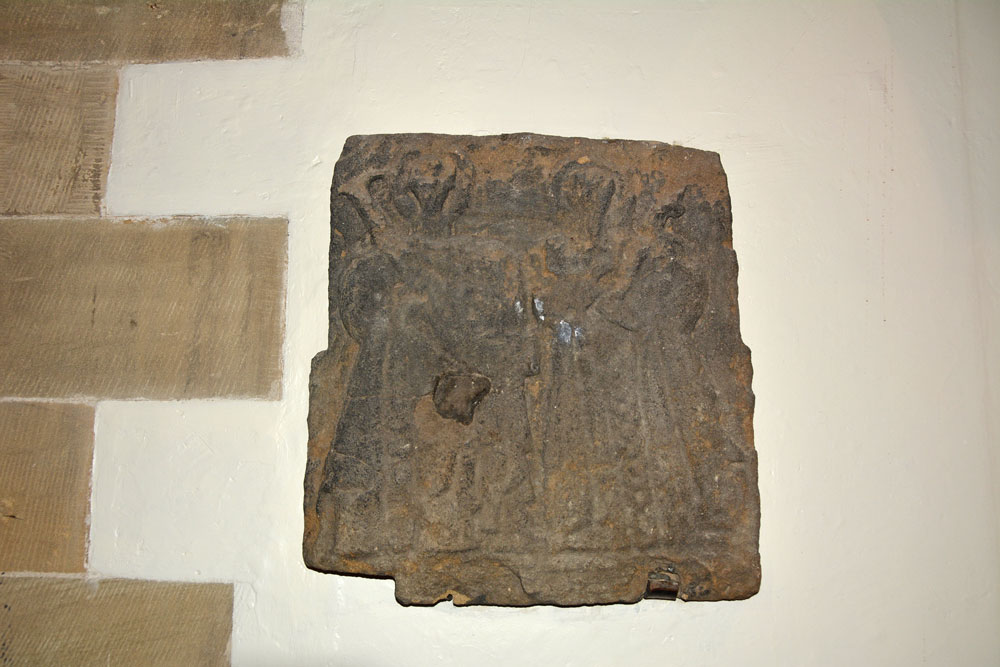
St Cuthbert's Church (Bedlington) submitted by Anne T on 13th Oct 2018. This carved stone, AS Corpus Bedlington 01, has now been built into the west wall of the nave, inside. The lighting is not brilliant, as it is sited immediately underneath the floor of the organ loft, and even with a flash, this was almost beyond my photographic skills. Dated to the tenth century, this worn slab has two figures, both with halos, the right hand figure holding a rod and with its right hand raised in blessing.
(View photo, vote or add a comment)
Log Text: St Cuthbert's Church, Bedlington: The Corpus told us the stone we were looking for was on the external east face of the nave. We were joined by a group of four boys who wandered into the churchyard and wondered what we were doing, so I told them, showed them the image, but none of us could find it. Looking through the architectural assessment I found it had been moved into the church and were on the west wall of the nave.
There were lights on in the church but the doors were locked. On our second try, the door opened and the Brownie Leader popped her head out. She very kindly let us into the church for a look around.
The south wall of the church is very old, but the rest of the exterior is Victorian. The nave of the church inside is incredible. Most of the grave markers were hidden behind the spiral staircase leading up to the organ, but I tried my best to photograph them.
St Mary The Virgin (Ponteland)
Trip No.102 Entry No.1 Date Added: 10th Oct 2018
Site Type: Ancient Cross
Country: England (Northumberland)
Visited: Yes on 9th Oct 2018. My rating: Condition 3 Ambience 4 Access 5
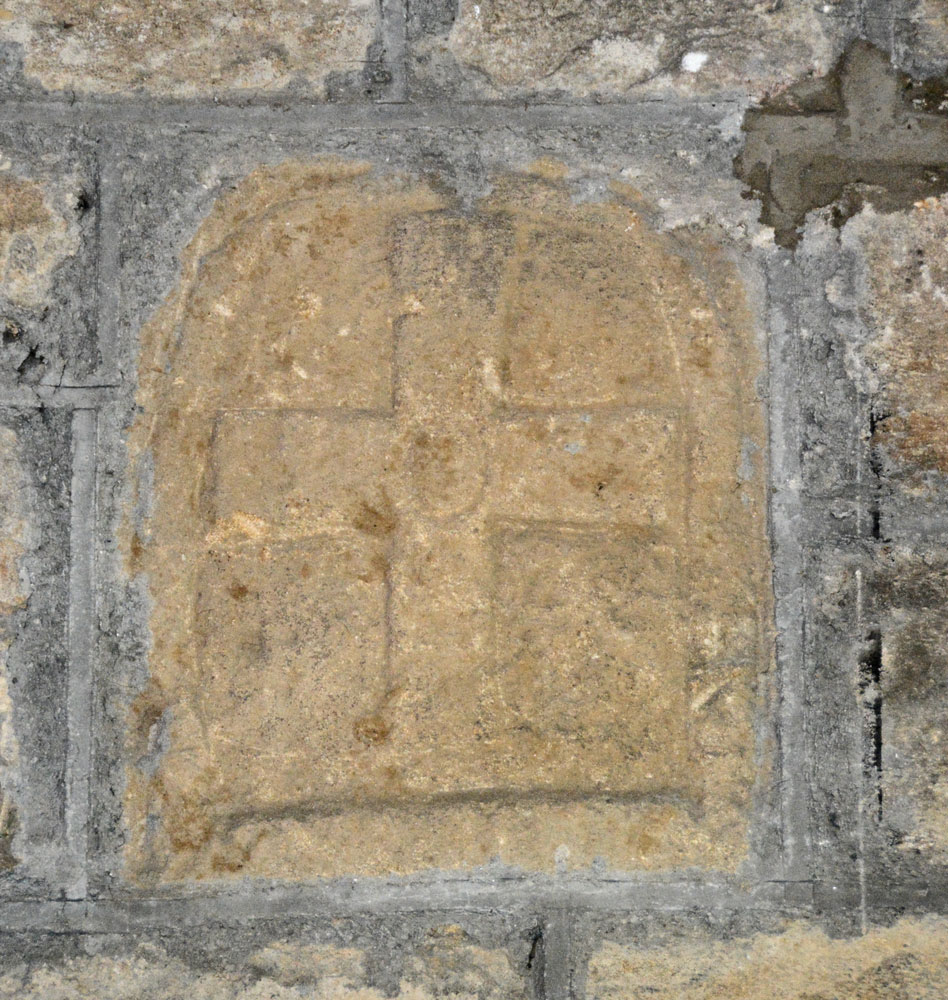
St Mary The Virgin (Ponteland) submitted by Anne T on 10th Oct 2018. The round headed, tenth century grave marker, to be found built into the south wall of the tower. Having moved the boxes off top of the cupboard, to get the best view, I had to sit half way up the wooden staircase to the top of the tower, and point the camera through the slats toward the stone. We also needed a torch as well as a flash to illuminate the stone to bring out the shadows to see the shape of the cross.
(View photo, vote or add a comment)
Log Text: 10th century grave marker, Ponteland: As this stone was one of only a few listed on the Corpus in Northumberland that we had still to see, we had previously visited on 20th September 2018, but were unable to get into the tower. Today, I’d arranged to meet church warden David Butler, plus another David, who had arranged to open the tower for us. They were building benches for memorials, so I had to step over the boxes.
The grave marker was largely hidden behind boxes on top of the cupboards, so we moved the crates, then I climbed half way up the wood steps to get a photo. Great fun!
We got into a conversations about wells, as we were heading off to Bamburgh. David told us that there used to be wells in Ponteland (he lives in a street called Ladywell), there are none remaining.
Bamburgh Castle
Trip No.102 Entry No.4 Date Added: 10th Oct 2018
Site Type: Sculptured Stone
Country: England (Northumberland)
Visited: Yes on 9th Oct 2018. My rating: Condition 3 Ambience 4 Access 3

Bamburgh Castle submitted by Anne T on 10th Oct 2018. This piece of carved stone is recorded in the Corpus of Anglo Saxon Stone Sculpture as the 'Bamburgh Castle' stone. Its style dates it to the last quarter of the eighth century to the first quarter of the ninth. Originally described in the 19th century as part of a large cross head, it is know known to be part of the arm of a stone chair or throne. A reproduction can be found outside the keep of the castle, although the Corpus says it is not clear if it is meant to be part of the back or seat.
(View photo, vote or add a comment)
Log Text: Wells and Anglo Saxon Stones at Bamburgh Castle: Note: there is disabled parking next to the State Rooms, but there are many stairs in and around the castle. It’s been a long time since we last came here, and the visit today happened because I’d been sent a 1947 Antiquarian paper about the holy wells of Northumberland. There was also one piece of AS stone in the archaeological museum; listed on the Corpus, which we had still to see.
It was sunny but windy, high up above the sea. It was expensive to get in, but actually was worth the money, as we spent hours here, both wandering around inside and outside.
We found another stone with Celtic Heads in the small Stones Museum, along with a 9th century mortar stone which had been reused to hold a post.
The carved Anglo Saxon stone was in the new Archaeological Museum and Activity area, and there is a recreation of the chair/throne the chair may have looked like outside the keep. This was a favourite for photographs for visitors, so we looked at when it got quieter at the end of the castle opening hours.
Before our visit, I had contacted the castle to try and ascertain the location of three wells inside the castle. There is one well in bottom of keep; the other on the outside wall of the castle at its north western end (no longer visible, but the site can be seen, although covered in sand). The third well we thought we’d found, as we walked up the old Victorian footpath to the castle from the beach, but we were mistaken as we’d had the 1860 OS map orientated wrongly!
Once we’d been round the castle near the ticket office (found when walking back to the car park from the old Victorian footpath from the beach to the castle).
St Aidan's Church (Bamburgh)
Trip No.102 Entry No.2 Date Added: 12th Oct 2018
Site Type: Early Christian Sculptured Stone
Country: England (Northumberland)
Visited: Yes on 9th Oct 2018. My rating: Condition 3 Ambience 4 Access 5

St Aidan's Church (Bamburgh) submitted by Anne T on 12th Oct 2018. "All that remains (of the original wooden church on this site) is a forked beam which can now be seen in the ceiling above the font. Bede’s account of Aidan’s death describes him as leaning against a beam when he died, in a shelter built for him outside the church. With the beam surviving at least two fires it became an object of veneration and was through to have miraculous healing qualities. People came to touch it and even take bits away. Years later it was built into the baptistry to k...
(View photo, vote or add a comment)
Log Text: St Aidan's Church, Bamburgh: We hadn’t intended to visit this church, but having seen two wells located in the property immediately to its east, we decided to take a look before heading off to the castle. The church is open during daylight hours, and is very welcoming, with lights in the nave, chancel and sanctuary, and a great display of literature and guide books.
With this church being so old (there was a cell of St Aidan and a monastery on the site), I was surprised there was no remnant of a preaching cross or cross base. To ensure I didn’t miss anything, I picked up the laminated church guide and ran through the features. It mentioned a timber from the original church, placed in the ceiling above the font. The church was so dark at this point (right at the west end of the church) that I sought lights to illuminate the spot, and looking up, indeed there was a very large (cruck) timber.
The guide also mentioned two old tombstones in the churchyard which are said to be older than the present church. I found one, but not the other.
Grace Darling also has a memorial in the churchyard.
Walking down the eastern wall of the churchyard and looking over to the farm buildings beyond, we identified the sites of two wells marked on the 1860 OS map.
St Aidan's Well (Bamburgh)
Trip No.102 Entry No.3 Date Added: 12th Oct 2018
Site Type: Holy Well or Sacred Spring
Country: England (Northumberland)
Visited: Yes on 9th Oct 2018. My rating: Condition 3 Ambience 3 Access 5
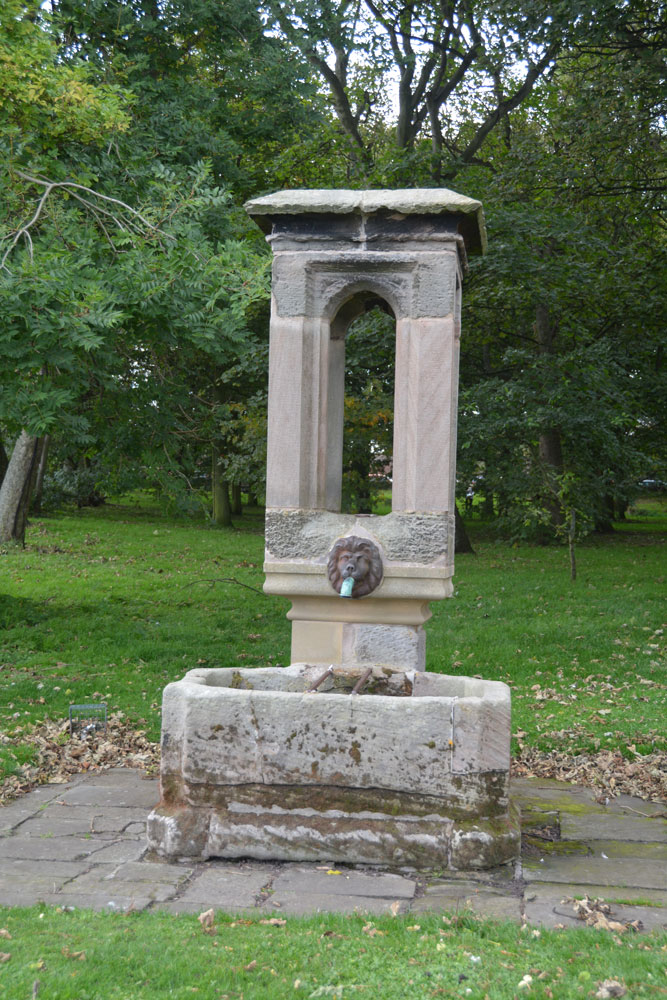
St Aidan's Well (Bamburgh) submitted by Anne T on 12th Oct 2018. First view of St Aidan's Well, standing just east of it, looking west across the triangular village green.
(View photo, vote or add a comment)
Log Text: St Aidan's Well, Bamburgh: This well seemed to form a ‘hub’ for visitors, with a school party and tourists sitting on the benches and grass around this structure, so we needed to make two trips to this well. By 5.30pm there was no one around (apart from the blue wheelie bins lined up along the street!). Obviously a modern structure, but this appears to be the original holy well associated with the church.
The well is now dry, which is a shame, as I'd have loved to see the water gushing into the basin. It might be a modern well housing, but this may well be an ancient site.
In 1947, when Revd Binnall and Miss Dodds produced their list and descriptions of Holy Wells in Northumberland and Durham, the village green was a small plantation of trees. Pastscape notes the name 'St Aidan's Well' is not known locally, but I don't know what it is called. The antiquarian notes mention it was mentioned as 'Edvn. Well' although I'm not sure was Edvn means.
Bamburgh Barrow 1
Trip No.102 Entry No.6 Date Added: 13th Oct 2018
Site Type: Round Barrow(s)
Country: England (Northumberland)
Visited: Saw from a distance on 9th Oct 2018. My rating: Condition 1 Ambience 3
Bamburgh Barrow 1 submitted by SolarMegalith on 13th Feb 2014. A Bronze Age cist with broken capstone and one of the upright stones visible (photo taken on February 2014).
(View photo, vote or add a comment)
Log Text: Rubbing Stone & Tumulus, Bamburgh: Spotted this apparent 'standing stone' in the field when we were walking back along Doctor's Lane towards St Aidan's Well. There was no obvious way into the field along this route, and we'd already walked for miles, so we contented ourselves with photographing from the stone wall in the next field.
On researching this site when I got home, found out that it was marked on the 1860 OS map as a tumulus with rubbing stone. The tumulus has now been destroyed and the stone is a 19th century insertion into the mound.
Had we realised there was still a visible cist, we might have tried harder to access the field. However, there is such a lot of history in Bamburgh, I'm sure we'll be making a return trip in the not too distant future.
